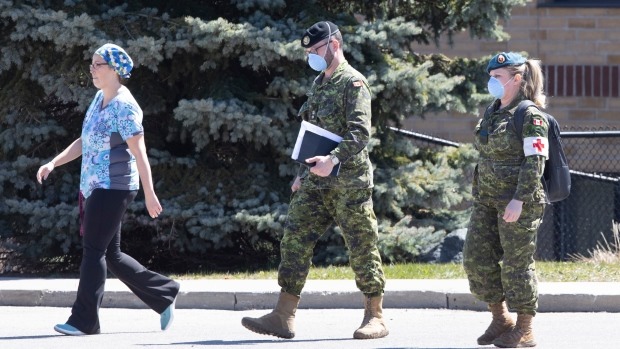Broad and frequent testing in Ontario’s long-term care homes was the key to gaining control of widespread and deadly COVID-19 outbreaks in those facilities, according to recently released transcripts of Canadian Armed Forces testimony provided to the independent commission investigating the spread of the virus in long-term care.
In the transcripts, which were released on Wednesday, military personnel identified many immediate and disturbing issues when they were first deployed to select long-term care facilities during the first wave of the pandemic, including staffing shortages, as well as supply management and communication issues.
In her testimony on Oct. 29, 2020, Major Karoline Martin said members of the military were “taken aback” when they arrived at the homes to find depleted staffing levels and deviations in the standard of care.
“When you have 80 per cent of the workforce being either temporary health agency staff or new hires, the understanding of what the culture within that long-term care facility is, what their policies and procedures are for clinical care is very, very challenging,” she said.
“So there was deviation sometimes based on the individual practitioner and sometimes based on a lack of knowledge of what was actually the standard of appropriate care.”
Cohorting, Martin said, was one of the main challenges faced by staff trying to get outbreaks under control.
“So the way that the movement of cohorting happened is once there was a batch of positive results, they then had to separate. And so it wasn’t moving one or two individuals. Early on in that pandemic, they were getting… double-digit positives early on, and so there was a massive movement of personnel, she said.
She noted that some facilities were able to block off an entire floor to house patients who tested positive for the virus, while others didn’t have the infrastructure to do that.
“They would have to move — like, Ward A suddenly had a cluster, and they would collect half the individuals, move them into Ward B,” she said.
“So you have this double movement of one person coming out, one person coming in and having to disinfect in between along with trying to keep track of all of their personal belongings. But from a staffing perspective, it was very, very challenging.”
She added that the “massive turnover of staff” created many issues with communication.
“Communication was extremely problematic internal to the facility partly because you had one individual from an agency or two individuals from an agency, but they were not coming in as a cohesive unit,” she said.
“So it was very hard to do that communication transfer between the various shifts or the various teams. And, again, because that communication wasn’t great, the handover of patients, or really starting to see patients decline from baseline, was problematic because it was just — it was a new team, a new individual every single day, and so you didn’t have that communication stream.”
Ultimately, widespread and frequent testing, she said, was the key to bringing the situation under control.
She added that when military personnel first arrived, agency staff could not be forced to undergo a test.
She also said that the staff who were being tested were not receiving tests frequently enough.
“When you have a testing regime, let’s say, on the 1st of the month, that’s a snapshot in time. And so two weeks, three weeks can go by in many of these facilities before they even do another round of swabbing,” she said.
“As you know from the virus, within a three-week period, you can actually have pretty significant outbreaks in that time.”
She said by the end of the deployment, the province began to mandate testing every two weeks within all long-term care facilities.
“What we actually saw was that many of our positives were asymptomatic. And so had we not been very, very frequent, very broad testing, we would have not caught those in time,” she said.
“That was a very collaborative effort with both the long-term care facilities, Toronto Public Health, and our military health authorities, and that worked extremely well.”
To date, there have been more than 2,000 COVID-19 related deaths in the province’s long-term care homes.
A final report from the Long-Term Care COVID-19 Commission is expected to be delivered on April 30, 2021.
Photo credit: THE CANADIAN PRESS/Chris Young
News source: CP24











